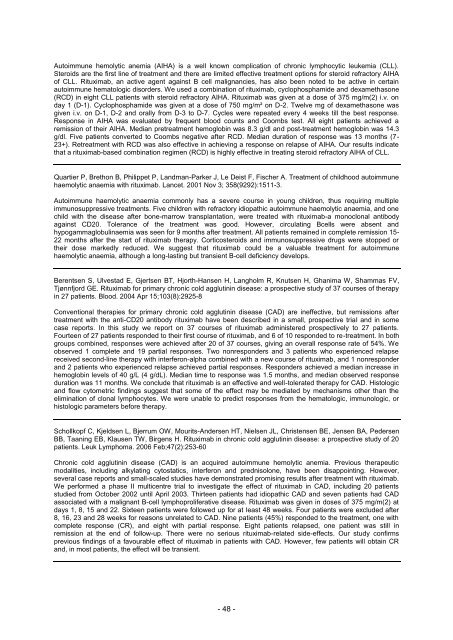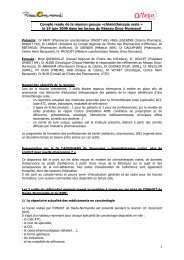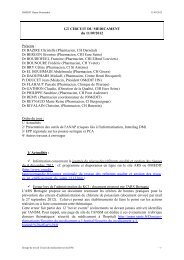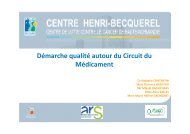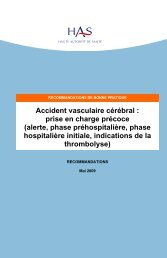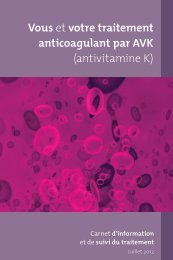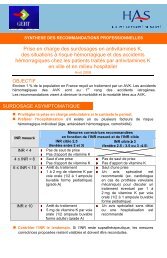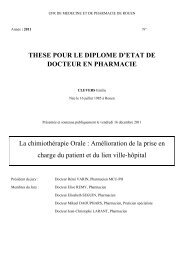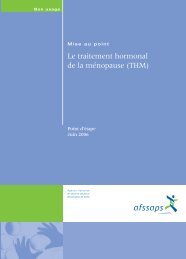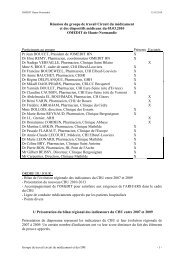RBU du Rituximab - OMéDIT de Haute-Normandie
RBU du Rituximab - OMéDIT de Haute-Normandie
RBU du Rituximab - OMéDIT de Haute-Normandie
You also want an ePaper? Increase the reach of your titles
YUMPU automatically turns print PDFs into web optimized ePapers that Google loves.
Autoimmune hemolytic anemia (AIHA) is a well known complication of chronic lymphocytic leukemia (CLL).<br />
Steroids are the first line of treatment and there are limited effective treatment options for steroid refractory AIHA<br />
of CLL. <strong>Rituximab</strong>, an active agent against B cell malignancies, has also been noted to be active in certain<br />
autoimmune hematologic disor<strong>de</strong>rs. We used a combination of rituximab, cyclophosphami<strong>de</strong> and <strong>de</strong>xamethasone<br />
(RCD) in eight CLL patients with steroid refractory AIHA. <strong>Rituximab</strong> was given at a dose of 375 mg/m(2) i.v. on<br />
day 1 (D-1). Cyclophosphami<strong>de</strong> was given at a dose of 750 mg/m² on D-2. Twelve mg of <strong>de</strong>xamethasone was<br />
given i.v. on D-1, D-2 and orally from D-3 to D-7. Cycles were repeated every 4 weeks till the best response.<br />
Response in AIHA was evaluated by frequent blood counts and Coombs test. All eight patients achieved a<br />
remission of their AIHA. Median pretreatment hemoglobin was 8.3 g/dl and post-treatment hemoglobin was 14.3<br />
g/dl. Five patients converted to Coombs negative after RCD. Median <strong>du</strong>ration of response was 13 months (7-<br />
23+). Retreatment with RCD was also effective in achieving a response on relapse of AIHA. Our results indicate<br />
that a rituximab-based combination regimen (RCD) is highly effective in treating steroid refractory AIHA of CLL.<br />
Quartier P, Brethon B, Philippet P, Landman-Parker J, Le Deist F, Fischer A. Treatment of childhood autoimmune<br />
haemolytic anaemia with rituximab. Lancet. 2001 Nov 3; 358(9292):1511-3.<br />
Autoimmune haemolytic anaemia commonly has a severe course in young children, thus requiring multiple<br />
immunosuppressive treatments. Five children with refractory idiopathic autoimmune haemolytic anaemia, and one<br />
child with the disease after bone-marrow transplantation, were treated with rituximab-a monoclonal antibody<br />
against CD20. Tolerance of the treatment was good. However, circulating Bcells were absent and<br />
hypogammaglobulinaemia was seen for 9 months after treatment. All patients remained in complete remission 15-<br />
22 months after the start of rituximab therapy. Corticosteroids and immunosuppressive drugs were stopped or<br />
their dose markedly re<strong>du</strong>ced. We suggest that rituximab could be a valuable treatment for autoimmune<br />
haemolytic anaemia, although a long-lasting but transient B-cell <strong>de</strong>ficiency <strong>de</strong>velops.<br />
Berentsen S, Ulvestad E, Gjertsen BT, Hjorth-Hansen H, Langholm R, Knutsen H, Ghanima W, Shammas FV,<br />
Tjønnfjord GE. <strong>Rituximab</strong> for primary chronic cold agglutinin disease: a prospective study of 37 courses of therapy<br />
in 27 patients. Blood. 2004 Apr 15;103(8):2925-8<br />
Conventional therapies for primary chronic cold agglutinin disease (CAD) are ineffective, but remissions after<br />
treatment with the anti-CD20 antibody rituximab have been <strong>de</strong>scribed in a small, prospective trial and in some<br />
case reports. In this study we report on 37 courses of rituximab administered prospectively to 27 patients.<br />
Fourteen of 27 patients respon<strong>de</strong>d to their first course of rituximab, and 6 of 10 respon<strong>de</strong>d to re-treatment. In both<br />
groups combined, responses were achieved after 20 of 37 courses, giving an overall response rate of 54%. We<br />
observed 1 complete and 19 partial responses. Two nonrespon<strong>de</strong>rs and 3 patients who experienced relapse<br />
received second-line therapy with interferon-alpha combined with a new course of rituximab, and 1 nonrespon<strong>de</strong>r<br />
and 2 patients who experienced relapse achieved partial responses. Respon<strong>de</strong>rs achieved a median increase in<br />
hemoglobin levels of 40 g/L (4 g/dL). Median time to response was 1.5 months, and median observed response<br />
<strong>du</strong>ration was 11 months. We conclu<strong>de</strong> that rituximab is an effective and well-tolerated therapy for CAD. Histologic<br />
and flow cytometric findings suggest that some of the effect may be mediated by mechanisms other than the<br />
elimination of clonal lymphocytes. We were unable to predict responses from the hematologic, immunologic, or<br />
histologic parameters before therapy.<br />
Schollkopf C, Kjeldsen L, Bjerrum OW, Mourits-An<strong>de</strong>rsen HT, Nielsen JL, Christensen BE, Jensen BA, Pe<strong>de</strong>rsen<br />
BB, Taaning EB, Klausen TW, Birgens H. <strong>Rituximab</strong> in chronic cold agglutinin disease: a prospective study of 20<br />
patients. Leuk Lymphoma. 2006 Feb;47(2):253-60<br />
Chronic cold agglutinin disease (CAD) is an acquired autoimmune hemolytic anemia. Previous therapeutic<br />
modalities, including alkylating cytostatics, interferon and prednisolone, have been disappointing. However,<br />
several case reports and small-scaled studies have <strong>de</strong>monstrated promising results after treatment with rituximab.<br />
We performed a phase II multicentre trial to investigate the effect of rituximab in CAD, including 20 patients<br />
studied from October 2002 until April 2003. Thirteen patients had idiopathic CAD and seven patients had CAD<br />
associated with a malignant B-cell lymphoproliferative disease. <strong>Rituximab</strong> was given in doses of 375 mg/m(2) at<br />
days 1, 8, 15 and 22. Sixteen patients were followed up for at least 48 weeks. Four patients were exclu<strong>de</strong>d after<br />
8, 16, 23 and 28 weeks for reasons unrelated to CAD. Nine patients (45%) respon<strong>de</strong>d to the treatment, one with<br />
complete response (CR), and eight with partial response. Eight patients relapsed, one patient was still in<br />
remission at the end of follow-up. There were no serious rituximab-related si<strong>de</strong>-effects. Our study confirms<br />
previous findings of a favourable effect of rituximab in patients with CAD. However, few patients will obtain CR<br />
and, in most patients, the effect will be transient.<br />
- 48 -


